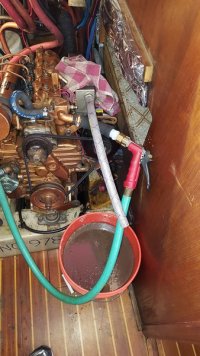Flushing the cooling system
I haven't read the hour meter yet, but using a stopwatch I figure I've got about 2 hours running on the reassembled engine. The injector fuel leaks are fixed.
Oil level is stable and the oil is clear. After about an hour with water and Cascade powder in the cooling system (no thermostat), I rigged the pictured flush "system" which is actually a piece of 3/4" nylon reinforced water hose, a 5 gallon bucket and the two hose adapters. I'll do another flush today, after I empty all my one gallon containers. And then probably do another one in a few more hours of running.
Flushing cooling systems on these engines turned out to be easier than I thought. "All you gotta do now is flush the cooling system" is kind of a tossed off phrase, as if everyone has done it. Except I don't usually do this myself. Since I'm this far into the repair, it seemed silly not to figure out how. The water squirter has a hose thread on the end, under the rubber protective cover, and this worked out very nicely for me. I was considering buying a ball valve to control the flow, but the squirter worked great. I might reverse the flow for the next flush.
Getting rid of the contaminated water and oil is another issue. Fortunately there is a Household Hazardous Waste collection site not too far from the marina and they're open Thursday through Saturday. They take coolant, oil and fuel, and any combination of contaminated fluids for free. I can get my containers back from this place in South Seattle, too, if I don't mind waiting. I think they take expired flares also. This beats putting all the fluids in the trash.

I haven't read the hour meter yet, but using a stopwatch I figure I've got about 2 hours running on the reassembled engine. The injector fuel leaks are fixed.
Oil level is stable and the oil is clear. After about an hour with water and Cascade powder in the cooling system (no thermostat), I rigged the pictured flush "system" which is actually a piece of 3/4" nylon reinforced water hose, a 5 gallon bucket and the two hose adapters. I'll do another flush today, after I empty all my one gallon containers. And then probably do another one in a few more hours of running.
Flushing cooling systems on these engines turned out to be easier than I thought. "All you gotta do now is flush the cooling system" is kind of a tossed off phrase, as if everyone has done it. Except I don't usually do this myself. Since I'm this far into the repair, it seemed silly not to figure out how. The water squirter has a hose thread on the end, under the rubber protective cover, and this worked out very nicely for me. I was considering buying a ball valve to control the flow, but the squirter worked great. I might reverse the flow for the next flush.
Getting rid of the contaminated water and oil is another issue. Fortunately there is a Household Hazardous Waste collection site not too far from the marina and they're open Thursday through Saturday. They take coolant, oil and fuel, and any combination of contaminated fluids for free. I can get my containers back from this place in South Seattle, too, if I don't mind waiting. I think they take expired flares also. This beats putting all the fluids in the trash.

Last edited:
